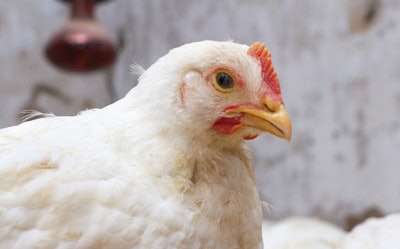
Over the past week, authorities in Denmark, England, Hungary and The Netherlands have confirmed their first outbreaks of highly pathogenic avian influenza (HPAI) among commercial poultry farms of the autumn/fall.
Among European commercial poultry flocks, 399 outbreaks of HPAI have occurred in 22 countries so far this year.
This is according to the latest update of the Animal Disease Information System from the European Commission (EC; as of November 3). This monitors the disease situation in European Union (EU) member states and neighboring countries. The total includes It also includes two outbreaks in Turkey (Tűrkiye) and one in the French overseas territory of Reunion — two territories that are not generally considered to belong to the continent of Europe.
For comparison, 24 nations registered a total of 2,321 outbreaks in commercial poultry flocks through this system during 2022.
Since the EC’s previous update on November 3, two further outbreaks in this population have been confirmed in Bulgaria and Hungary, and one in Denmark. These bring the national totals for the year so far to eight, 81, and seven, respectively.
Of the 2023 running total, the country with the most outbreaks — 152 — continues to be France, although the figure has not changed since mid-July.
Among captive birds, 15 European countries have together registered a total of 92 outbreaks of HPAI in captive birds through the EC’s system to November 10. Included in this category are non-commercial poultry flocks, and birds other than poultry, such as zoos. The situation is unchanged from the previous update dated November 3.
Avian flu hiatus ends with season’s first cases on farms on 4 countries
Further details of notifiable disease outbreaks are reported by national veterinary agencies to the World Organisation for Animal Health (WOAH).
Over the past 10 days, the Hungarian authority has notified WOAH about five outbreaks on commercial farms in different regions of the country. Testing positive for the H5N1 HPAI virus serotype have been poultry in three counties in the northeast of the country, and two in the south. With one exception — the country’s first outbreak of the season among 22,500 birds in Hajdu-Bihar — flock sizes are not specified in the reports.
Following a one-month hiatus, the same virus variant was detected again earlier this month in Denmark.
According to WOAH notifications, two outbreaks have been confirmed so far. First to be affected were around 33,000 meat turkeys in Region Zealand, and this was followed within a few days by an outbreak in 2,300 poultry across the other side of the country in the Region of Southern Denmark.
From the Netherlands, a WOAH notification confirms the detection of the H5N1 virus serotype in a free-range layer flock in the central province of Utrecht. Of the 64,900 birds at the farm, 35 died and the rest have been destroyed.
Within a 10-km radius of the premises, there is a ban on transportation of poultry, according to the Dutch agriculture ministry. This affects just over 200 poultry farms, including more than 30 within a 3-km radius of the outbreak, which will be subject to intensive monitoring for the following 10 days.
It was only at the start of this month that the ministry lifted the mandatory housing rules for poultry in the last two regions of the Netherlands.
Following confirmation of the latest outbreak, the restrictions were restored. Under the published regulation, appropriate measures must be put in place to prevent commercial poultry from coming into contact with wild birds or their droppings. This applies to all commercial birds (except pheasants, ratites, and ornamental water birds) in the regions of North and Central Drenthe, and Ijssel-Vecht.
In the United Kingdom (U.K.), the first HPAI outbreak of the season in poultry has been confirmed recently in England.
Testing positive for the H5N1 virus earlier this month were poultry at a farm in the eastern country of Lincolnshire, according to the agriculture department, Defra.
Latest update of the European Reference Laboratory (EURL) Avian Flu Data Portal indicates that an HPAI virus of an as-yet unidentified type was detected at a farm in Italy earlier this week.
13 states record new HPAI infections in wild species
Over the period November 3-10, 11 European states notified the EC about one or more cases of HPAI in their respective wild bird populations.
Up to the latter date, a total of 3,334 outbreaks had been registered in 28 states of the EU member and adjacent states, according to the EC System. This was an increase of 16 since the previous update, and includes the first outbreak of 2023 in Portugal.
For comparison, 3,245 outbreaks were confirmed in 33 of the region’s nations during 2022.
Germany continues to be the state with the most outbreaks (1,068 for the year to date), followed by France (404).
Each reporting between one and three outbreaks in wild birds to the EC since the previous update were Austria, Germany, Hungary, Iceland, Italy, Norway, Romania, Serbia, Spain, and Sweden.
While the U.K. (apart from Northern Ireland) is also not covered by the EC System, the national animal health agency has notified WOAH over the past week about three further H5N1-positive cases in wild birds.
Since June of this year, outbreaks linked to the H5N1 HPAI virus have been confirmed in animals other than birds in Finland.
Latest notification to WOAH indicates the number of this country's fur farms with cases has risen by one to 32. In addition, there have been two separate cases in wild mammals.
A first outbreak for the region of Southwestern Finland, the premises reported four cases among 3,900 Arctic foxes and one out of 9,000 American mink.
All the country's previous outbreaks were in the region of Western and Inland Finland.
View our continuing coverage of the global avian influenza situation.


















